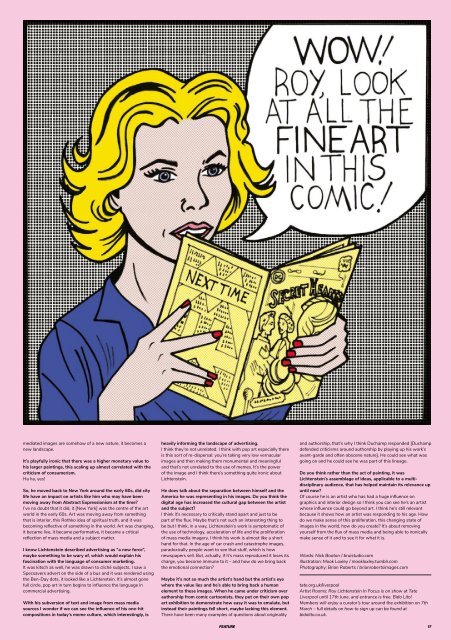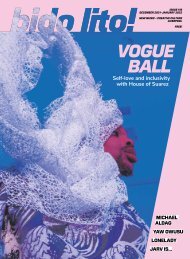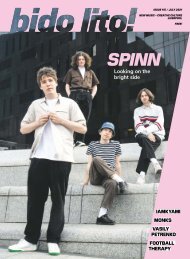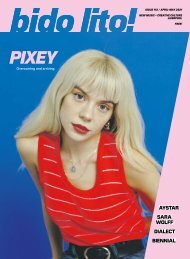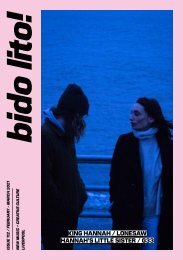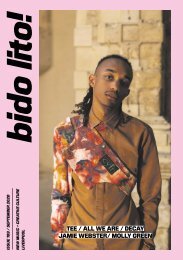Issue 86 / March 2018
March 2018 issue of Bido Lito! magazine. Featuring: ELEANOR NELLY, BREAK WAVE, FIELD MUSIC, EVERYMAN THEATRE, JORJA SMITH, GARY NUMAN and much more.
March 2018 issue of Bido Lito! magazine. Featuring: ELEANOR NELLY, BREAK WAVE, FIELD MUSIC, EVERYMAN THEATRE, JORJA SMITH, GARY NUMAN and much more.
Create successful ePaper yourself
Turn your PDF publications into a flip-book with our unique Google optimized e-Paper software.
mediated images are somehow of a new nature, it becomes a<br />
new landscape.<br />
It’s playfully ironic that there was a higher monetary value to<br />
his larger paintings, this scaling up almost correlated with the<br />
criticism of consumerism.<br />
Ha ha, yes!<br />
So, he moved back to New York around the early 60s, did city<br />
life have an impact on artists like him who may have been<br />
moving away from Abstract Expressionism at the time?<br />
I’ve no doubt that it did, it [New York] was the centre of the art<br />
world in the early 60s. Art was moving away from something<br />
that is interior, this Rothko idea of spiritual truth, and it was<br />
becoming reflective of something in the world. Art was changing,<br />
it became live, it became performative, it became a critical<br />
reflection of mass media and a subject matter.<br />
I know Lichtenstein described advertising as “a new force”,<br />
maybe something to be wary of, which would explain his<br />
fascination with the language of consumer marketing.<br />
It was kitsch as well, he was drawn to cliché subjects. I saw a<br />
Specsavers advert on the side of a bus and it was rendered using<br />
the Ben-Day dots, it looked like a Lichtenstein. It’s almost gone<br />
full circle, pop art in turn begins to influence the language in<br />
commercial advertising.<br />
With his subversion of text and image from mass media<br />
sources I wonder if we can see the influence of his one-hit<br />
compositions in today’s meme culture, which interestingly, is<br />
heavily informing the landscape of advertising.<br />
I think they’re not unrelated. I think with pop art especially there<br />
is this sort of re-dispersal: you’re taking very low vernacular<br />
images and then making them monumental and meaningful<br />
and that’s not unrelated to the use of memes. It’s the power<br />
of the image and I think there’s something quite ironic about<br />
Lichtenstein.<br />
He does talk about the separation between himself and the<br />
America he was representing in his images. Do you think the<br />
digital age has increased the cultural gap between the artist<br />
and the subject?<br />
I think it’s necessary to critically stand apart and just to be<br />
part of the flux. Maybe that’s not such an interesting thing to<br />
be but I think, in a way, Lichtenstein’s work is symptomatic of<br />
the use of technology, acceleration of life and the proliferation<br />
of mass media imagery, I think his work is almost like a short<br />
hand for that. In the age of car crash and catastrophe images,<br />
paradoxically people want to see that stuff, which is how<br />
newspapers sell. But, actually, if it’s mass reproduced it loses its<br />
charge, you become immune to it – and how do we bring back<br />
the emotional connection?<br />
Maybe it’s not so much the artist’s hand but the artist’s eye<br />
where the value lies and he’s able to bring back a human<br />
element to these images. When he came under criticism over<br />
authorship from comic cartoonists, they put on their own pop<br />
art exhibition to demonstrate how easy it was to emulate, but<br />
instead their paintings fell short, maybe lacking this element.<br />
There have been many examples of questions about originality<br />
and authorship, that’s why I think Duchamp responded [Duchamp<br />
defended criticisms around authorship by playing up his work’s<br />
avant-garde and often obscene nature]. He could see what was<br />
going on and he could see he was part of this lineage.<br />
Do you think rather than the act of painting, it was<br />
Lichtenstein’s assemblage of ideas, applicable to a multidisciplinary<br />
audience, that has helped maintain its relevance up<br />
until now?<br />
Of course he is an artist who has had a huge influence on<br />
graphics and interior design so I think you can see he’s an artist<br />
whose influence could go beyond art. I think he’s still relevant<br />
because it shows how an artist was responding to his age. How<br />
do we make sense of this proliferation, this changing state of<br />
images in the world, how do you create? It’s about removing<br />
yourself from the flux of mass media and being able to ironically<br />
make sense of it and to see it for what it is.<br />
Words: Nick Booton / bruistudio.com<br />
Illustration: Mook Loxley / mookloxley.tumblr.com<br />
Photography: Brian Roberts / brianrobertsimages.com<br />
tate.org.uk/liverpool<br />
Artist Rooms: Roy Lichtenstein In Focus is on show at Tate<br />
Liverpool until 17th June, and entrance is free. Bido Lito!<br />
Members will enjoy a curator’s tour around the exhibition on 7th<br />
<strong>March</strong> – full details on how to sign up can be found at<br />
bidolito.co.uk.<br />
FEATURE<br />
17


